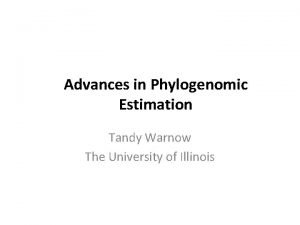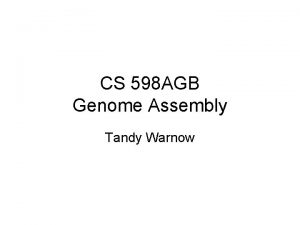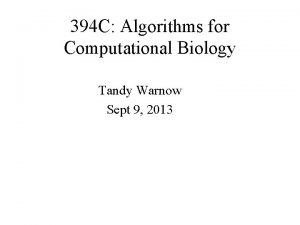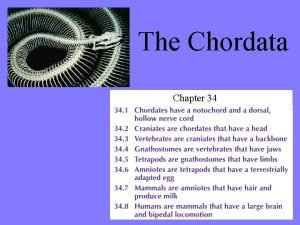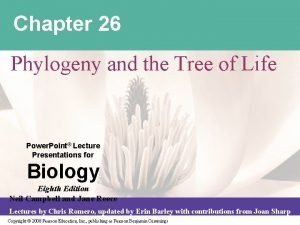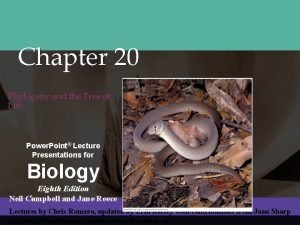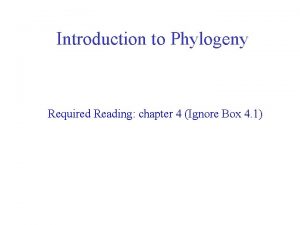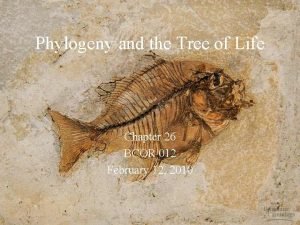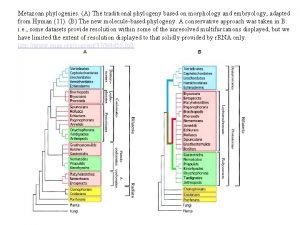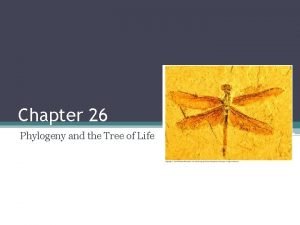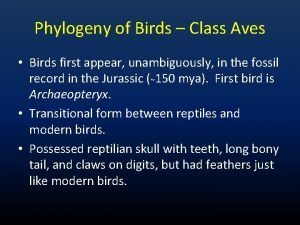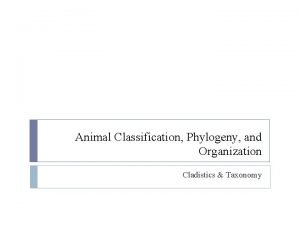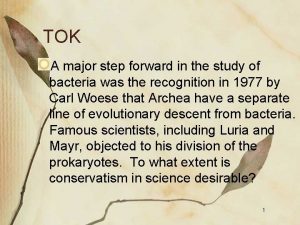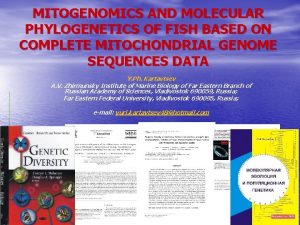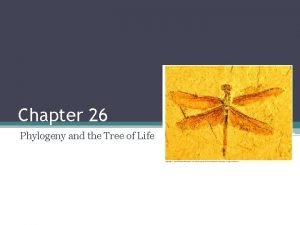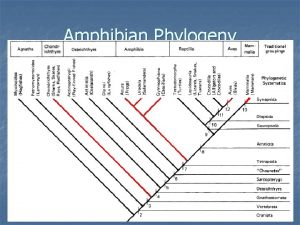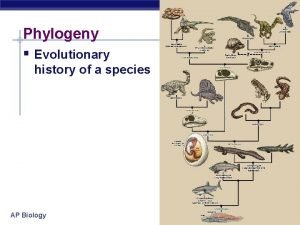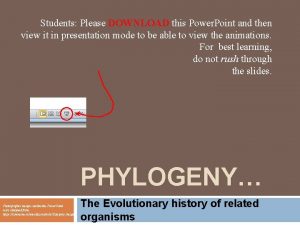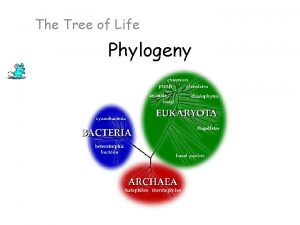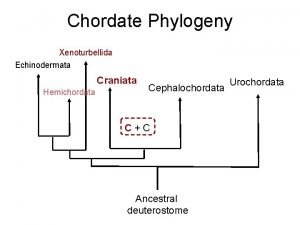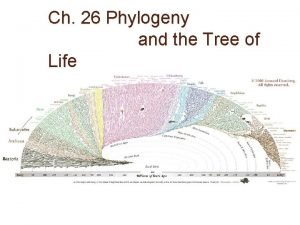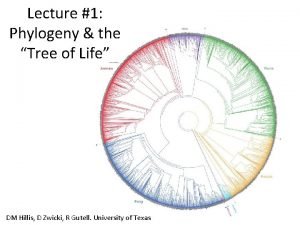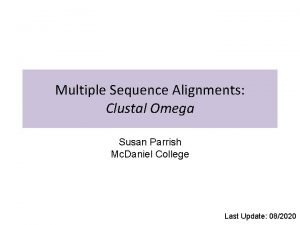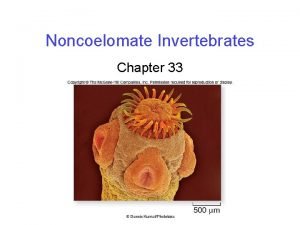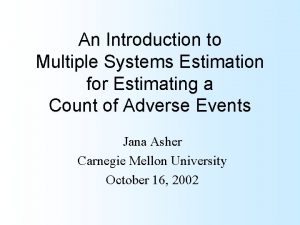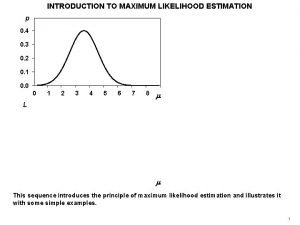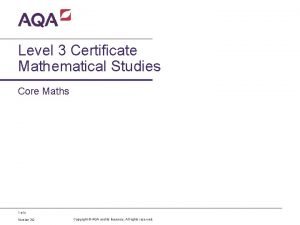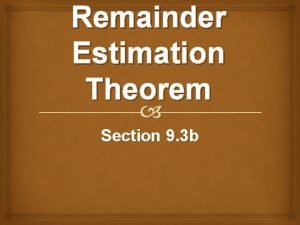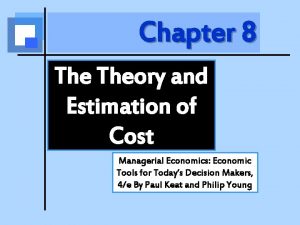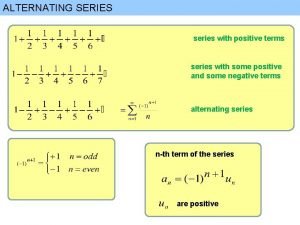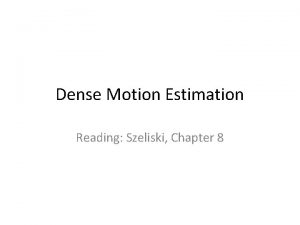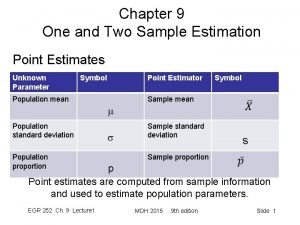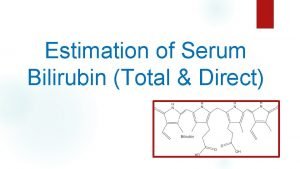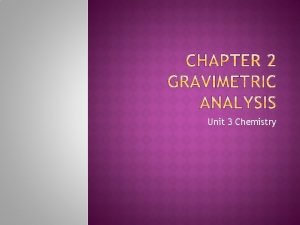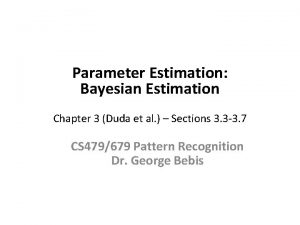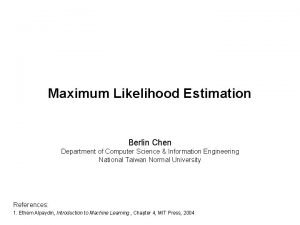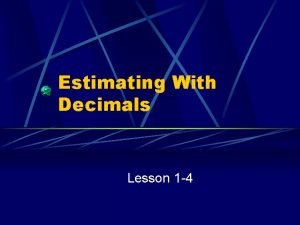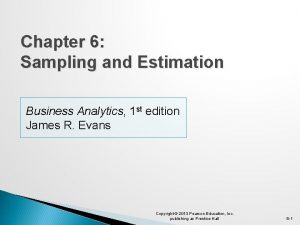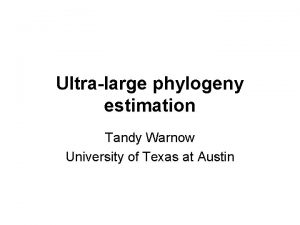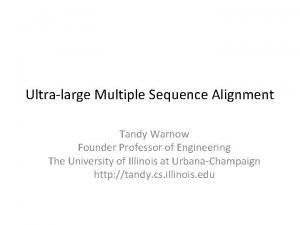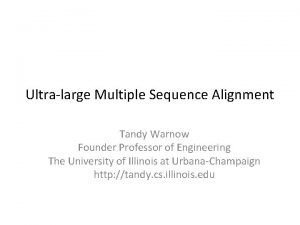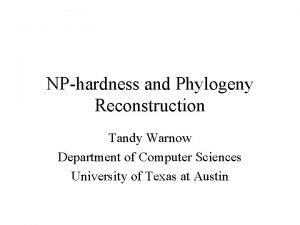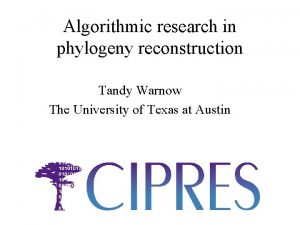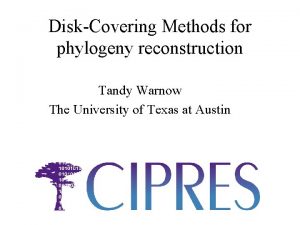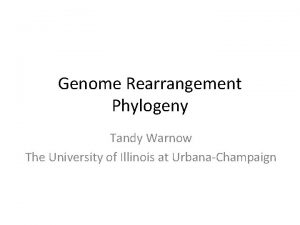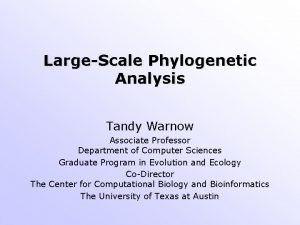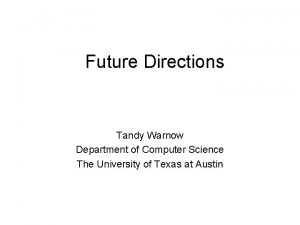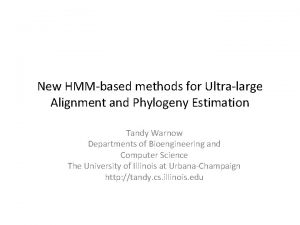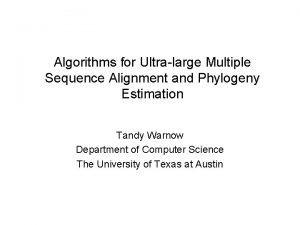Advances in Ultralarge Phylogeny Estimation Tandy Warnow Department






















![DCM 1 -boosting distance-based methods [Nakhleh et al. ISMB 2001] Error Rate 0. 8 DCM 1 -boosting distance-based methods [Nakhleh et al. ISMB 2001] Error Rate 0. 8](https://slidetodoc.com/presentation_image_h/1022f067ba0d2fd9256508380d534ef9/image-23.jpg)



























































- Slides: 82

Advances in Ultra-large Phylogeny Estimation Tandy Warnow Department of Computer Science University of Texas

Phylogeny (evolutionary tree) Orangutan From the Tree of the Life Website, University of Arizona Gorilla Chimpanzee Human

How did life evolve on earth? Courtesy of the Tree of Life project

Where did humans come from, and how did they move throughout the globe? The 1000 Genome Project: using human genetic variation to better treat diseases

Metagenomics: C. Venter et al. , Exploring the Sargasso Sea: Scientists Discover One Million New Genes in Ocean Microbes

Major Challenges • Current phylogenetic datasets contain hundreds to thousands of taxa, with multiple genes. • Future datasets will be substantially larger (e. g. , i. Plant plans to construct a tree on 500, 000 plant species) • Current methods have poor accuracy or cannot run on large datasets.

Computational Phylogenetics Current methods can use months to estimate trees on 1000 DNA sequences Our objective: More accurate trees and alignments on 500, 000 sequences in under a week We prove theorems using graph theory and probability theory, and our algorithms are studied on real and Courtesy of the Tree of Life project simulated data.

DNA Sequence Evolution -3 mil yrs AAGACTT AAGGCCT AGGGCAT TAGCCCA -2 mil yrs TGGACTT TAGACTT AGCACAA AGCGCTT -1 mil yrs today

Deletion Substitution …ACGGTGCAGTTACCA… Insertion …ACCAGTCACCTA… …ACGGTGCAGTTACC-A… …AC----CAGTCACCTA… The true multiple alignment – Reflects historical substitution, insertion, and deletion events – Defined using transitive closure of pairwise alignments computed on edges of the true tree

U V W AGGGCATGA AGAT X TAGACTT Y TGCACAA X U Y V W TGCGCTT

Input: unaligned sequences S 1 S 2 S 3 S 4 = = AGGCTATCACCTGACCTCCA TAGCTATCACGACCGC TAGCTGACCGC TCACGACA

Phase 1: Multiple Sequence Alignment S 1 S 2 S 3 S 4 = = AGGCTATCACCTGACCTCCA TAGCTATCACGACCGC TAGCTGACCGC TCACGACA S 1 S 2 S 3 S 4 = = -AGGCTATCACCTGACCTCCA TAG-CTATCAC--GACCGC-TAG-CT-------GACCGC----TCAC--GACCGACA

Phase 2: Construct tree S 1 S 2 S 3 S 4 = = AGGCTATCACCTGACCTCCA TAGCTATCACGACCGC TAGCTGACCGC TCACGACA S 1 S 4 S 1 S 2 S 3 S 4 S 2 S 3 = = -AGGCTATCACCTGACCTCCA TAG-CTATCAC--GACCGC-TAG-CT-------GACCGC----TCAC--GACCGACA

Simulation Studies S 1 = AGGCTATCACCTGACCTCCA S 2 = TAGCTATCACGACCGC S 3 = TAGCTGACCGC S 4 = TCACGACA Unaligned Sequences S 1 = AGGCTATCACCTGACCTCCA S 2 = TAG-CTATCAC--GACCGC-S 3 = TAG-CT-------GACCGC-S 4 = -------TCAC--GACCGACA S 1 S 2 S 4 S 3 True tree and alignment S 1 = AGGCTATCACCTGACCTCCA S 2 = TAG-CTATCAC--GACCGC-S 3 = TAG-C--T-----GACCGC-S 4 = T---C-A-CGACCGA----CA S 1 S 4 Compare S 2 S 3 Estimated tree and alignment

The neighbor joining method has high error rates on large trees Error Rate 0. 8 NJ Simulation study based upon fixed edge lengths, K 2 P model of evolution, sequence lengths fixed to 1000 nucleotides. Error rates reflect proportion of incorrect edges in inferred trees. 0. 6 0. 4 0. 2 [Nakhleh et al. ISMB 2001] 0 0 400 800 No. Taxa 1200 1600

1000 taxon models, ordered by difficulty (Liu et al. , 2009)

Problems • Large datasets with high rates of evolution are hard to align accurately, and phylogeny estimation methods produce poor trees when alignments are poor. • Many phylogeny estimation methods have poor accuracy on large datasets (even if given correct alignments) • Potentially useful genes are often discarded if they are difficult to align. These issues seriously impact large-scale phylogeny estimation (and Tree of Life projects)

Major Challenges • Current phylogenetic datasets contain hundreds to thousands of taxa, with multiple genes. • Future datasets will be substantially larger (e. g. , i. Plant plans to construct a tree on 500, 000 plant species) • Current methods have poor accuracy or cannot run on large datasets.

Phylogenetic “boosters” (meta-methods) Goal: improve accuracy, speed, robustness, or theoretical guarantees of base methods Examples: • DCM-boosting for distance-based methods (1999) • DCM-boosting for heuristics for NP-hard problems (1999) • SATé-boosting for alignment methods (2009) • Super. Fine-boosting for supertree methods (2011) • DACTAL-boosting for all phylogeny estimation methods (2011) • SEPP-boosting for metagenomic analyses (2011)

Disk-Covering Methods (DCMs) (starting in 1998)

• DCMs “boost” the performance of phylogeny reconstruction methods. Base method M DCM-M

The neighbor joining method has high error rates on large trees Error Rate 0. 8 NJ Simulation study based upon fixed edge lengths, K 2 P model of evolution, sequence lengths fixed to 1000 nucleotides. Error rates reflect proportion of incorrect edges in inferred trees. 0. 6 0. 4 0. 2 [Nakhleh et al. ISMB 2001] 0 0 400 800 No. Taxa 1200 1600
![DCM 1 boosting distancebased methods Nakhleh et al ISMB 2001 Error Rate 0 8 DCM 1 -boosting distance-based methods [Nakhleh et al. ISMB 2001] Error Rate 0. 8](https://slidetodoc.com/presentation_image_h/1022f067ba0d2fd9256508380d534ef9/image-23.jpg)
DCM 1 -boosting distance-based methods [Nakhleh et al. ISMB 2001] Error Rate 0. 8 NJ DCM 1 -NJ 0. 6 0. 4 0. 2 0 0 400 800 No. Taxa 1200 • Theorem: DCM 1 -NJ converges to the true tree from polynomial length sequences 1600

Today’s Talk • SATé: Simultaneous Alignment and Tree Estimation (Liu et al. , Science 2009, and Liu et al. Systematic Biology, in press) • DACTAL: Divide-and-Conquer Trees (Almost) without alignments (Nelesen et al. , submitted) • SEPP: SATé-enabled Phylogenetic Placement (Mirarab, Nguyen and Warnow, to appear, PSB 2012)

Part 1: SATé Liu, Nelesen, Raghavan, Linder, and Warnow, Science, 19 June 2009, pp. 1561 -1564. Liu et al. , Systematic Biology (in press) Public software distribution (open source) through the University of Kansas, in use, world-wide

1000 taxon models, ordered by difficulty (Liu et al. , 2009)

SATé Algorithm Obtain initial alignment and estimated ML tree Tree

SATé Algorithm Obtain initial alignment and estimated ML tree Tree Use tree to compute new alignment Alignment

SATé Algorithm Obtain initial alignment and estimated ML tree Tree Use tree to compute new alignment Estimate ML tree on new alignment Alignment

SATé Algorithm Obtain initial alignment and estimated ML tree Tree Use tree to compute new alignment Estimate ML tree on new alignment Alignment If new alignment/tree pair has worse ML score, realign using a different decomposition Repeat until termination condition (typically, 24 hours)

One SATé iteration (really 32 subsets) A B e C Decompose based on input tree D Estimate ML tree on merged alignment A B C D Align subproblems ABCD A B C D Merge subproblems

1000 taxon models, ordered by difficulty

1000 taxon models, ordered by difficulty 24 hour SATé analysis, on desktop machines (Similar improvements for biological datasets)

1000 taxon models ranked by difficulty

Limitations of SATé-I and -II C A B D Decompose dataset Estimate ML tree on merged alignment ABCD A B C D Align subproblem s A B C D Merge subalignments

Part II: DACTAL (Divide-And-Conquer Trees (Almost) without alignments) • Input: set S of unaligned sequences • Output: tree on S (but no alignment) (Nelesen, Liu, Wang, Linder, and Warnow, submitted)

DACTAL BLASTbased Unaligned Sequences p. Rec. DCM 3 A tree for the entire dataset Existing Method: RAx. ML(MAFFT) Overlapping subsets New supertree method: Super. Fine A tree for each subset

Average of 3 Largest CRW Datasets CRW: Comparative RNA database, Three 16 S datasets with 6, 323 to 27, 643 sequences Reference alignments based on secondary structure Reference trees are 75% RAx. ML bootstrap trees DACTAL (shown in red) run for 5 iterations starting from FT(Part) Fast. Tree (FT) and RAx. ML are ML methods

Observations • DACTAL gives more accurate trees than all other methods on the largest datasets • DACTAL is much faster than SATé • DACTAL is robust to starting trees and other algorithmic parameters

Part III: SEPP • SEPP: SATé-enabled Phylogenetic Placement, by Mirarab, Nguyen, and Warnow • To appear, Pacific Symposium on Biocomputing, 2012 (special session on the Human Microbiome)

Metagenomic data analysis NGS data produce fragmentary sequence data Metagenomic analyses include unknown species Taxon identification: given short sequences, identify the species for each fragment Applications: Human Microbiome Issues: accuracy and speed

Phylogenetic Placement Input: Backbone alignment and tree on fulllength sequences, and a set of query sequences (short fragments) Output: Placement of query sequences on backbone tree Phylogenetic placement can be used for taxon identification, but it has general applications for phylogenetic analyses of NGS data.

Phylogenetic Placement ● ● Align each query sequence to backbone alignment Place each query sequence into backbone tree, using extended alignment

Align Sequence S 1 S 2 S 3 S 4 Q 1 = = = -AGGCTATCACCTGACCTCCA-AA TAG-CTATCAC--GACCGC--GCA TAG-CT-------GACCGC--GCT TAC----TCAC--GACCGACAGCT TAAAAC S 1 S 4 S 2 S 3

Align Sequence S 1 S 2 S 3 S 4 Q 1 = = = -AGGCTATCACCTGACCTCCA-AA TAG-CTATCAC--GACCGC--GCA TAG-CT-------GACCGC--GCT TAC----TCAC--GACCGACAGCT -------T-A--AAAC---- S 1 S 4 S 2 S 3

Place Sequence S 1 S 2 S 3 S 4 Q 1 = = = -AGGCTATCACCTGACCTCCA-AA TAG-CTATCAC--GACCGC--GCA TAG-CT-------GACCGC--GCT TAC----TCAC--GACCGACAGCT -------T-A--AAAC---- S 1 S 4 S 2 Q 1 S 3

Phylogenetic Placement • Align each query sequence to backbone alignment – HMMALIGN (Eddy, Bioinformatics 1998) – Pa. Ra (Berger and Stamatakis, Bioinformatics 2011) • Place each query sequence into backbone tree – Pplacer (Matsen et al. , BMC Bioinformatics, 2011) – EPA (Berger and Stamatakis, Systematic Biology 2011) Note: pplacer and EPA use maximum likelihood

HMMER vs. Pa. Ra Alignments 0. 0 Increasing rate of evolution

Insights from SATé

Insights from SATé

Insights from SATé

Insights from SATé

Insights from SATé

SEPP Parameter Exploration § § Alignment subset size and placement subset size impact the accuracy, running time, and memory of SEPP 10% rule (subset sizes 10% of backbone) had best overall performance

SEPP (10%-rule) on simulated data 0. 0 Increasing rate of evolution

SEPP (10%) on Biological Data 16 S. B. ALL dataset, 13 k curated backbone tree, 13 k total fragments For 1 million fragments: Pa. Ra+pplacer: ~133 days HMMALIGN+pplacer: ~30 days SEPP 1000/1000: ~6 days

SEPP (10%) on Biological Data 16 S. B. ALL dataset, 13 k curated backbone tree, 13 k total fragments For 1 million fragments: Pa. Ra+pplacer: ~133 days HMMALIGN+pplacer: ~30 days SEPP 1000/1000: ~6 days

Three “Boosters” • SATé: co-estimation of alignments and trees • DACTAL: large trees without full alignments • SEPP: phylogenetic analysis of fragmentary data Algorithmic strategies: divide-and-conquer and iteration to improve the accuracy and scalability of a base method

Summary • Standard alignment and phylogeny estimation methods do not provide adequate accuracy on large datasets, and NGS data present novel challenges • When markers tend to yield poor alignments and trees, develop better methods - don’t throw out the data.

Acknowledgments • Guggenheim Foundation Fellowship, Microsoft Research New England, National Science Foundation: Assembling the Tree of Life (ATOL), ITR, and IGERT grants, and David Bruton Jr. Professorship • Collaborators: – SATé: Kevin Liu, Serita Nelesen, Sindhu Raghavan, and Randy Linder – DACTAL: Serita Nelesen, Kevin Liu, Li-San Wang, and Randy Linder – SEPP: Siavash Mirarab and Nam Nguyen

Current Research Projects Method development: • Large-scale multiple sequence alignment and phylogeny estimation • Metagenomics • Comparative genomics • Estimating species trees from gene trees • Supertree methods • Phylogenetic estimation under statistical models Dataset analyses (multi-institutional collaborations): • Avian Phylogeny (and brain evolution) • Human Microbiome • Thousand Transcriptome (1 KP) Project • Conifer evolution

Current Research Projects Method development: • Large-scale multiple sequence alignment and phylogeny estimation • Metagenomics • Comparative genomics • Estimating species trees from gene trees • Supertree methods • Phylogenetic estimation under statistical models Dataset analyses (multi-institutional collaborations): • Avian Phylogeny (and brain evolution) • Human Microbiome • Thousand Transcriptome (1 KP) Project • Conifer evolution

Red gene tree ≠ species tree (green gene tree okay)

Multi-marker species tree estimation • Species phylogenies are estimated using multiple gene trees. Most methods assume that all gene trees are identical to the species tree. • This is known to be unrealistic in some situations, due to processes such as • Deep Coalescence • Gene duplication and loss • Horizontal gene transfer • MDC problem: Given set of gene trees, find a species tree that minimizes the total number of “deep coalescences”.

Yu, Warnow and Nakhleh, 2011 • Previous software for MDC assumed all gene trees are correct, completely resolved, and rooted. • Our methods allow for error in estimated gene trees. • We provide exact algorithms and heuristics to find an optimal species tree with respect to a given set of partially resolved, unrooted gene trees, minimizing the total number of deep coalescences. • Software at http: //bioinfo. cs. rice. edu/phylonet/ To appear, RECOMB 2011 and J. Computational Biology, special issue for RECOMB 2011. Talk about this topic today at 2 PM in OEB.

Markov Model of Site Evolution Simplest (Jukes-Cantor): • The model tree T is binary and has substitution probabilities p(e) on each edge e. • The state at the root is randomly drawn from {A, C, T, G} (nucleotides) • If a site (position) changes on an edge, it changes with equal probability to each of the remaining states. • The evolutionary process is Markovian. More complex models (such as the General Markov model) are also considered, often with little change to theory.

SATé-I vs. SATé-II • Faster and more accurate than SATé-I • Longer analyses or use of ML to select tree/alignment pair slightly better results

Percent Informative Sites Divergence & Information Content 100 75 Exons UTRs Introns 50 25 0 0. 05 0. 10 0. 15 0. 20 0. 25 0. 30 Average Pairwise Sequence Divergence Analysis and figure provided by Mike Braun Smithsonian Institution

Reticulate evolution • Not all evolution is tree-like: – Horizontal gene transfer – Hybrid speciation • How can we detect reticulate evolution?


Grading • Homeworks 50% • Final exam 30% • Class participation 10% • Class project 10%

U AGGGCAT V W TAGCCCA X TAGACTT Y TGCACAA X U Y V W TGCGCTT

Two-phase estimation Phylogeny methods Alignment methods • Clustal • POY (and POY*) • Probcons (and Probtree) • Probalign • MAFFT • Muscle • Di-align • T-Coffee • Prank (PNAS 2005, Science 2008) • Opal (ISMB and Bioinf. 2007) • FSA (PLo. S Comp. Bio. 2009) • Infernal (Bioinf. 2009) • Etc. • Bayesian MCMC • Maximum parsimony • Maximum likelihood • Neighbor joining • Fast. ME • UPGMA • Quartet puzzling • Etc. RAx. ML: heuristic for large-scale ML optimization

Software In use by research groups around the world • Kansas SATé software developers: Mark Holder, Jiaye Yu, and Jeet Sukumaran • Downloadable software for various platforms • Easy-to-use GUI • http: //phylo. bio. ku. edu/software/sate. html

Quantifying Error FN FN: false negative (missing edge) FP: false positive (incorrect edge) 50% error rate FP

Understanding SATé • Observations: (1) subsets of taxa that are small enough, closely related, and densely sampled are aligned more accurately than others. • SATé-1 produces subsets that are closely related and densely sampled, but not small enough. • SATé-2 (“next SATé”) changes the design to produce smaller subproblems. • The next iteration starts with a more accurate tree. This leads to a better alignment, and a better tree.

Biology: 21 st Century Science! “When the human genome was sequenced seven years ago, scientists knew that most of the major scientific discoveries of the 21 st century would be in biology. ” January 1, 2008, guardian. co. uk

Genome Sequencing Projects: Started with the Human Genome Project

Whole Genome Sequencing: Graph Algorithms and Combinatorial Optimization!

Other Genome Projects! (Neandertals, Wooly Mammoths, and more ordinary creatures…)

Phylogeny (evolutionary tree) Orangutan From the Tree of the Life Website, University of Arizona Gorilla Chimpanzee Human

Metagenomics • Input: set of sequences • Output: a tree on the set of sequences, indicating the species identification of each sequence • Issue: the sequences are not globally alignable, and there are often thousands (or more) of the sequences
 Tandy warnow
Tandy warnow Tandy warnow
Tandy warnow Tandy warnow
Tandy warnow Fineboosting
Fineboosting Tandy warnow
Tandy warnow Tandy warnow
Tandy warnow Tandy warnow
Tandy warnow Tandy warnow
Tandy warnow Tandy trower
Tandy trower Hoaloha robotics
Hoaloha robotics Advances in real time rendering
Advances in real time rendering Photodesintegration
Photodesintegration Taly payroll
Taly payroll Irac guidelines
Irac guidelines Short term loans and advances
Short term loans and advances Advances in technology during wwii
Advances in technology during wwii Lurbinectedin posologie
Lurbinectedin posologie Opto-electronic advances
Opto-electronic advances Child development chapter 9
Child development chapter 9 Advances in memory technology
Advances in memory technology Chapter 17 section 2 the axis advances
Chapter 17 section 2 the axis advances Recent advances in ceramics
Recent advances in ceramics Phylogeny is the study of _____.
Phylogeny is the study of _____. Anatomy of trout
Anatomy of trout Phylogeny
Phylogeny Chapter 20 phylogeny and the tree of life
Chapter 20 phylogeny and the tree of life Rooted phylogenetic tree
Rooted phylogenetic tree Phylogenetic tree
Phylogenetic tree Phylogeny and the tree of life chapter 26
Phylogeny and the tree of life chapter 26 Bryozoa
Bryozoa Crab cladogram
Crab cladogram Chapter 26 phylogeny and the tree of life
Chapter 26 phylogeny and the tree of life Dinosauria
Dinosauria Phylogeny
Phylogeny Outgroup on a cladogram
Outgroup on a cladogram Ontogeny recapitulates phylogeny
Ontogeny recapitulates phylogeny Fish phylogeny
Fish phylogeny Chapter 26 phylogeny and the tree of life
Chapter 26 phylogeny and the tree of life Phylogenetics vs taxonomy
Phylogenetics vs taxonomy Kingdom animalia cladogram
Kingdom animalia cladogram Amphibian heart
Amphibian heart Cat family tree
Cat family tree Monophyletic group
Monophyletic group Ingroup phylogenetic tree
Ingroup phylogenetic tree Craniata
Craniata Chapter 26 phylogeny and the tree of life
Chapter 26 phylogeny and the tree of life Basal taxon definition biology
Basal taxon definition biology Phylogeny
Phylogeny Ncbi clustal omega
Ncbi clustal omega Arthropoda phylogeny
Arthropoda phylogeny Phylogeny of invertebrates
Phylogeny of invertebrates Photos
Photos Multiple systems estimation
Multiple systems estimation Project size
Project size Density estimation trees
Density estimation trees Maximum liklihood
Maximum liklihood Fermi estimation core maths
Fermi estimation core maths Remainder estimation theorem
Remainder estimation theorem Maximum likelihood estimation
Maximum likelihood estimation Demand estimation and forecasting
Demand estimation and forecasting Barometric methods are used to forecast
Barometric methods are used to forecast Estimation of cost function in managerial economics
Estimation of cost function in managerial economics Alternating series estimation theorem
Alternating series estimation theorem Dense motion estimation
Dense motion estimation Fermi estimation
Fermi estimation Point estimation
Point estimation Elevated direct bilirubin causes
Elevated direct bilirubin causes Gravimetric method
Gravimetric method What is estimation and costing in electrical engineering
What is estimation and costing in electrical engineering God and pod method
God and pod method Metrics for project size estimation
Metrics for project size estimation Kloc cocomo
Kloc cocomo Bayesian parameter estimation in pattern recognition
Bayesian parameter estimation in pattern recognition Maximum likelihood estimator variance
Maximum likelihood estimator variance Rounding decimals lesson
Rounding decimals lesson Cost estimation
Cost estimation Cost of software engineering
Cost of software engineering Steve wyborney 20 days of number sense
Steve wyborney 20 days of number sense Sampling and estimation methods in business analytics
Sampling and estimation methods in business analytics Production theory and estimation
Production theory and estimation Cocomo cost estimation model
Cocomo cost estimation model The dirty pei
The dirty pei Software cost estimation notes
Software cost estimation notes




